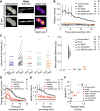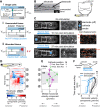Osmolarity-independent electrical cues guide rapid response to injury in zebrafish epidermis
- PMID: 33225997
- PMCID: PMC7721437
- DOI: 10.7554/eLife.62386
Osmolarity-independent electrical cues guide rapid response to injury in zebrafish epidermis
Abstract
The ability of epithelial tissues to heal after injury is essential for animal life, yet the mechanisms by which epithelial cells sense tissue damage are incompletely understood. In aquatic organisms such as zebrafish, osmotic shock following injury is believed to be an early and potent activator of a wound response. We find that, in addition to sensing osmolarity, basal skin cells in zebrafish larvae are also sensitive to changes in the particular ionic composition of their surroundings after wounding, specifically the concentration of sodium chloride in the immediate vicinity of the wound. This sodium chloride-specific wound detection mechanism is independent of cell swelling, and instead is suggestive of a mechanism by which cells sense changes in the transepithelial electrical potential generated by the transport of sodium and chloride ions across the skin. Consistent with this hypothesis, we show that electric fields directly applied within the skin are sufficient to initiate actin polarization and migration of basal cells in their native epithelial context in vivo, even overriding endogenous wound signaling. This suggests that, in order to mount a robust wound response, skin cells respond to both osmotic and electrical perturbations arising from tissue injury.
Keywords: cell biology; cell migration; cell polarization; developmental biology; electric field; epidermis; transepithelial potential; wound healing; zebrafish.
© 2020, Kennard and Theriot.
Conflict of interest statement
AK, JT No competing interests declared
Figures







Similar articles
-
Wounding Zebrafish Larval Epidermis by Laceration.Bio Protoc. 2021 Dec 20;11(24):e4260. doi: 10.21769/BioProtoc.4260. eCollection 2021 Dec 20. Bio Protoc. 2021. PMID: 35087919 Free PMC article.
-
Osmotic surveillance mediates rapid wound closure through nucleotide release.J Cell Biol. 2014 Dec 22;207(6):767-82. doi: 10.1083/jcb.201408049. J Cell Biol. 2014. PMID: 25533845 Free PMC article.
-
Imaging the electric field associated with mouse and human skin wounds.Wound Repair Regen. 2008 May-Jun;16(3):432-41. doi: 10.1111/j.1524-475X.2008.00389.x. Wound Repair Regen. 2008. PMID: 18471262 Free PMC article.
-
Skin development in bony fish with particular emphasis on collagen deposition in the dermis of the zebrafish (Danio rerio).Int J Dev Biol. 2004;48(2-3):217-31. doi: 10.1387/ijdb.15272388. Int J Dev Biol. 2004. PMID: 15272388 Review.
-
The Electrical Response to Injury: Molecular Mechanisms and Wound Healing.Adv Wound Care (New Rochelle). 2014 Feb 1;3(2):184-201. doi: 10.1089/wound.2013.0442. Adv Wound Care (New Rochelle). 2014. PMID: 24761358 Free PMC article. Review.
Cited by
-
Come together: On-chip bioelectric wound closure.Biosens Bioelectron. 2021 Nov 15;192:113479. doi: 10.1016/j.bios.2021.113479. Epub 2021 Jul 8. Biosens Bioelectron. 2021. PMID: 34265520 Free PMC article.
-
Environmental and molecular control of tissue-specific ionocyte differentiation in zebrafish.bioRxiv [Preprint]. 2024 Jan 13:2024.01.12.575421. doi: 10.1101/2024.01.12.575421. bioRxiv. 2024. Update in: Development. 2024 Oct 15;151(20):dev202809. doi: 10.1242/dev.202809. PMID: 38260427 Free PMC article. Updated. Preprint.
-
Wounding Zebrafish Larval Epidermis by Laceration.Bio Protoc. 2021 Dec 20;11(24):e4260. doi: 10.21769/BioProtoc.4260. eCollection 2021 Dec 20. Bio Protoc. 2021. PMID: 35087919 Free PMC article.
-
Large-scale control over collective cell migration using light-controlled epidermal growth factor receptors.bioRxiv [Preprint]. 2024 May 31:2024.05.30.596676. doi: 10.1101/2024.05.30.596676. bioRxiv. 2024. Update in: Cell Syst. 2025 Mar 19;16(3):101203. doi: 10.1016/j.cels.2025.101203. PMID: 38853934 Free PMC article. Updated. Preprint.
-
Perivascular Macrophages Convert Physical Wound Signals Into Rapid Vascular Responses.bioRxiv [Preprint]. 2024 Dec 12:2024.12.09.627538. doi: 10.1101/2024.12.09.627538. bioRxiv. 2024. PMID: 39713421 Free PMC article. Preprint.
References
-
- Allan D, Caswell TA, van der Wel C, Dimiduk T, PIMS Contributors PIMS: Python Image Sequence. 0.4.1Github. 2015 https://soft-matter.github.io/pims/v0.4
Publication types
MeSH terms
Substances
Grants and funding
LinkOut - more resources
Full Text Sources
Other Literature Sources
Molecular Biology Databases
Research Materials

